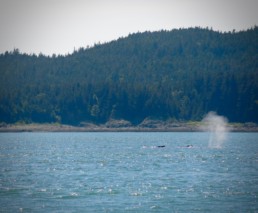This essay was first published in Wanderlust Journal, November 2017.
I listened to the dusty dragging of feet several paces behind me, on a curving forest pathway hemming a sunlit bay. The sound of whining children must surely be excellent bear repellent, and I counted this small nugget among the riches of this Alaskan summer morning. Daniel and Maya had been intrepid ten-year-old explorers so far on this Midwest-to-Northwest journey, which had already included a two-day, cross country train trip, a blustery early morning ferry crossing, and (gasp!) feeble and sporadic Internet access. The rustic national park lodge, disappearing into the Sitka spruce on the trail behind us, was comfortably furnished with plush chairs, a warm fireplace, and unpredictable but accessible Wi-Fi in one very particular location in the lobby, enough that a kid might hold out hope for a momentary connection with a digital clan or cyber farm in need of attention. My husband, John, did his best to bolster the troops, commenting on the beautiful mountains, the sky, the ocean. The kids glanced at their traitor, knowing that he too would enjoy a few unscheduled hours of hiking-boots-off, legs-draped-over-chairs, patchy Internet surfing. Erratic connectivity would be less chancy than a Mom-led family hike into the unknown.
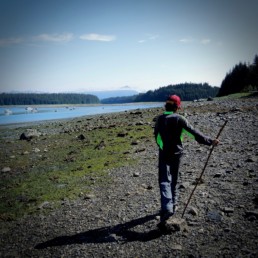
The sound of whining children must surely be excellent bear repellent, and I counted this small nugget among the riches of this Alaskan summer morning.
After a decade of parenting, travel planning decisions have become more complicated. The tree-hugging, hippie explorer and the practical, protective mama bear in me, generally coexisting side-by-side in peace, will then sit down and have a schizophrenic discussion over tea. I believe in the power of the natural world, the gift of immersion in soul-rich wild places. I’ve seen what happens when my family unplugs, not just from electronics and cyber-social connections, but in letting go of daily routines engineered in concrete and speed. Often this can happen with simple things — a Sunday bike ride through a local forest preserve, or an evening picnic in the park. But sometimes a deeper dive is needed, leaving a precious, indelible mark. We think, feel, and speak differently hiking a tree line trail or paddling a glacier-fed lake. And so begin the questions… Are the kids coordinated enough to navigate this narrow, boulder-strewn trail at six thousand feet without launching themselves off the edge? If we tip the canoe in the pristine glacial lake, how long until hypothermia sets in? And then I worry… that I have become a worrier. I read about three-year-old children that are allowed to climb tall trees in Scandinavia, encouraging self-reliance without a safety net. I witnessed young boys herding goats in a vast Kenyan desert, barefoot, alone, and completely in charge. Infants are nursed in tents and on trails, and itinerant families wander the planet in peace. And so for some people, our little adventures would read like a tame, soothing bedtime story. Others might believe that anything not involving a safety harness or cartoon character is exotic and maybe a little dangerous. Vacation time is precious, and the things that excite, relax, and unite a family are unique and to be respected. So far we’ve hit the right balance for our own family pretty well, but there has admittedly been some trial and error involved. The biggest risk and challenge, more than physical safety, may be in finding the right balance of activity to calm, planned to unscheduled. The travel planner has learned this the hard way, because she is now, well into her forties, just beginning to learn how to sit still.
I believe in the power of the natural world, the gift of immersion in soul-rich wild places. I’ve seen what happens when my family unplugs, not just from electronics and cyber-social connections, but in letting go of daily routines engineered in concrete and speed.
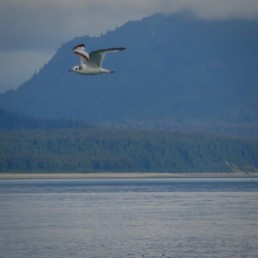
We had arrived by ferry two days earlier in Gustavus, the tiny town that is home to Glacier Bay National Park. The four-hour crossing was more eventful than anticipated, with bracing winds and churning waves breaking over the railings of the M/V LeConte, one of the smallest and oldest vessels in the Alaska Marine Highway fleet. It would be the first of four ferry crossings on this trip, and while the other sailings turned out to be sunny and serene, we didn’t yet know if this was the usual state of affairs or a reason to scope out the life rafts. After stopping in Gustavus the ferry would continue on to the small native village of Hoonah, and the regular commuters on board seemed unfazed by the roiling sea. The captain did finally make an announcement in that nonchalant captain way, telling us we should probably take our seats because the trip was a little “rockin’ and rollin’.” When we finally arrived in port, we dragged ourselves and our bags up the gangway as the blasting wind forced us backwards and drove rain pellets into our faces. In the distance we spied the ancient brown school bus that would carry us, bouncing and dripping, to the lodge several miles away. We climbed aboard, the kids’ faces wind-whipped and red, their eyes dancing and alive. John smiled at me, shook his head, and wiped the remains of the deluge off his face.
Many of the retold stories in our family lore involve travels in the rain. The previous summer we watched open-mouthed and panic-laughing as our children, harnessed to a grinning, twenty-year-old guide, disappeared into the rain forest canopy on a zip line in a driving Costa Rican rainstorm. At that moment the option for weak-kneed parents to back out evaporated, so we followed, six hundred feet in the air on several miles of zip line, needles of rain soaking through raincoats and stinging faces. Two years earlier we stayed at an off-the-grid cabin deep in the Canadian Rockies. The final 40 miles of road were gravel, and another blinding rainstorm had turned cavernous potholes into murky, muddy lakes. John, gingerly guiding our rented Subaru sedan through a newborn lake of unknown depth, proclaimed, “This is officially the craziest place you have ever taken us!” A couple of days later we were dropped off with a canoe further down the gravel road, to paddle on a crystalline lake in the summer morning sunshine. Half an hour later, thunder echoed off the surrounding granite mountain walls and the sky opened up. We have a little video of the kids calmly hunched in their raincoats eating peanut butter sandwiches and discussing the relative pitfalls and merits of the trip so far.
Maybe they get a kick out of all of this because even our early life together involved rainy misadventures. For six weeks in 2005 we lived in northern Kazakhstan to complete the adoption journey that would make us a family. After two weeks of summer-ending rain, the sun made a glorious appearance through the windows of the gray cinderblock apartment. We enthusiastically bundled up our newly adopted children for a walk around town. As the late afternoon sun dramatically disappeared into a leaden sky, we realized we had taken a wrong turn. With no map and limited language, we somehow navigated our way back through muddy alleys, sheltering our two seven-month-old babies under our coats from the steady, soaking rain. Wide-eyed and smiling, they snuggled against our chests, giggling a tentative approval of this partially protected experience of the world — and of the directionally challenged and rain soaked people that were now their loving parents.
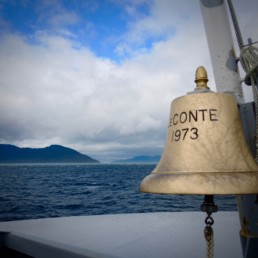
The four-hour crossing was more eventful than anticipated, with bracing winds and churning waves breaking over the railings of the M/V LeConte, one of the smallest and oldest vessels in the Alaska Marine Highway fleet. It would be the first of four ferry crossings on this trip, and while the other sailings turned out to be sunny and serene, we didn’t yet know if this was the usual state of affairs or a reason to scope out the life rafts.
But today… today was not raining. In fact, the sun was shining warm on our shoulders and raising diamonds from the depths of Bartlett Cove. We had spent the previous day on board a catamaran on a chilly, windswept journey to the northern reaches of Glacier Bay. Our bodies were still humming from the thrill of it: ethereal blue glaciers calving thunderously into the sea; breaching humpback whales heaving their enormous, lithe bodies from the frigid depths; thick-coated grizzlies ambling on platter-sized paws along rock-strewn shores; sea lion bachelors barking a gravelly tune and basking in the fleeting sun. The play of light on glaciers and sea, mountains and sky, painted the expansive landscape in magic. Outside on the deck we bundled against the snow-wrapped wind. Inside we scanned the waves for sea otters and puffins, eavesdropping on the kayakers seated behind us. They would be dropped off on a remote, rocky beach and picked up again five days later. The campers were in their twenties and thirties, except for one woman in her seventies, a former backcountry guide. She pulled out battered geologic maps from the 1960’s to show the group as they planned their expedition. Her small frame was a bit bent but strong, her skin leathered and glowing. Married and living in Juneau, she faithfully came out once or twice a year for a multi-day kayaking expedition. We had a chance to talk before she and her group were set down on the secluded shore. Her blue eyes sparkled and held my gaze. “Oh, you should try it, dear. You would love it.” I watched and waved to the lifelong explorer I hoped to be, as the big engines reversed and left the rainbow of kayaks and paddlers on the pewter shore. I turned back to my kids, huddled close to me on the windy upper deck, and suggested we go back inside for hot chocolate. They wrapped their arms around my waist, and I was full and grateful, content in the family-sized adventure we shared in that moment.
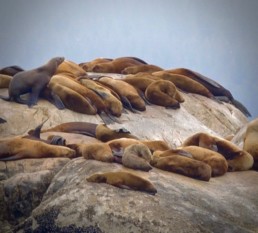
Our bodies were still humming from the thrill of it: ethereal blue glaciers calving thunderously into the sea; breaching humpback whales heaving their enormous, lithe bodies from the frigid depths; thick-coated grizzlies ambling on platter-sized paws along rock-strewn shores; sea lion bachelors barking a gravelly tune and basking in the fleeting sun.
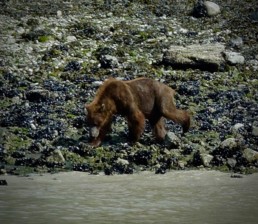
And so this day, sun-laden and still, unstructured and unplanned, slid off the back of the windblown excitement of the day before. It was July 4th, and we couldn’t have been further from the usual parades, picnics and fireworks that usually accompany the holiday. We had declined a trip into town to participate in the “festivities” as described by the perky lodge staff, young people from around the world who had come to this isolated part of Alaska for summer work. We would, in fact, witness some of those festivities later in the afternoon as the old brown school bus inched its way through town revelers, on the way to the single runway airstrip. We gawked out half-opened windows at a teenage boy shimmying a greased horizontal pole over a meandering river, attempting to grab the prized hundred-dollar bill affixed to the end. But earlier in the day the kids had set aside the opportunity for games and a parade, in order to “just stay here” at the lodge. This coerced march into nature was probably not what they had in mind.
High school science taught me that “nature abhors a vacuum,” and I admit that my own nature also struggles with empty space and unfilled time, especially when we travel. Breaks in the action are needed and planned, in order to avoid the spectacular sorts of meltdowns that come with children pushed past their limits. But when we find ourselves in an amazing place, a place we might only see once, the wanderer in me wants to suck the marrow out of every single moment. And if the day is warm and sunlit and we are perched on the edge of a sparkling bay, sitting inside is out of the question, not only for me, but also for the beloved young explorers that we must sherpa through this world. I considered possible void-filling, marrow-sucking options as the path sloped gently toward the shore, and the beloved young explorers began pestering their sherpas for a plan. We could still rent bikes at the lodge and pedal the nearly empty roads. Maybe there were kayaks available at the boathouse down the way. My suggestion of joining the park rangers on their daily guided hike had already been rejected earlier in the morning. We reached the shore without a plan, the wide Alaskan sky and our unscheduled time overwhelming and expansive.
And so this day, sun-laden and still, unstructured and unplanned, slid off the back of the windblown excitement of the day before.
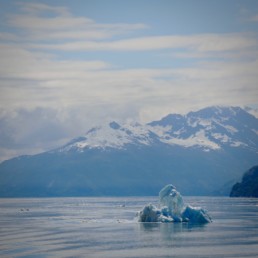
The tide was low, and as we approached the dock the kids noted the exposed, barnacle-encrusted posts towering into the hazy sky, posts that had been mostly submerged the previous morning when boarding the boat. I smiled, knowing that at least the impressive change in the tide had caught their attention. We poked through the garden of seaweed in the dark, wet sand, the waterlogged yellow bulbs squirting raucously under our feet. A gentle, briny breeze whispered across the bay, and bald eagles rode invisible currents above our heads. A few fishing boats nestled in the harbor, rocking lazily as the sun blazed its endless summer arch across the northern sky.
A middle-aged, backpack-laden couple strode quickly past us on the beach, crossed a sandbar in the distance, and headed into the thick forest. I followed in the same general direction, since they at least looked purposeful and adventurous. Daniel scrambled ahead and mounted an elephantine boulder, brandishing a driftwood sword. John and Maya lagged behind, poking at minuscule crabs in the sand. The general mood was beginning to elevate, as the walk became less about Mom and movement, and more about dawdling and discovery.
Daniel and I followed the sound of a gurgling stream. A clear, shallow river wound its way through spruce and hemlock, bouncing over rocks as it sang its way to the mouth of the bay. We scrambled over glacial remains, enormous slabs of timeworn granite, and squelched our way through salty, porous earth. Daniel lost a shoe in the mud, and I picked my way over marginally drier ground to retrieve it. We sat down on a large flat rock to rinse the mud-caked shoe in the stream, and discovered that we were surrounded by tide pools. Daniel’s eyes became enormous as he laughed and exclaimed, “Mom, look! Anemones!”
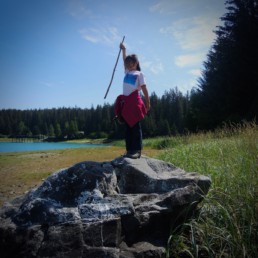
The general mood was beginning to elevate, as the walk became less about Mom and movement, and more about dawdling and discovery.
Maya and John continued their slow meander across the seaweed-strewn sand, as Daniel leaped up from the rock and bellowed down the beach, “Guys! Come on! Tide pools!” We crouched at the water’s edge, dipping our fingers in the clear, frigid pools, proclaiming each new find. Red-orange sea stars hugged slippery stones, thousands of little feet propelling them lackadaisically from one end of a rock to another. Diminutive gray sculpins darted and jerked, the bright sun glistening and bouncing off their sleek bodies. Clear anemones waved jellied tentacles in the current, while thumbprint-sized crabs darted through our cupped hands.
We crouched at the water’s edge, dipping our fingers in the clear, frigid pools, proclaiming each new find.
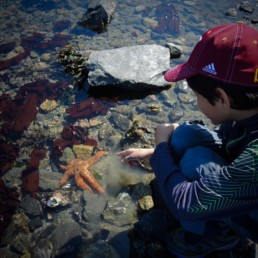
Two hundred years ago this land was invisible, reclaimed and remade by the slow, crushing shift of glacial ice. In geological terms, it is time’s half-breath, a mere inhalation. In our own human history, these forests and tide pools are still young adolescents, and we played delightedly in their laps. On the horizon, against a bright blue sky, stood the great, ancient mothers, snow-covered peaks keeping watch over time and generations, from sea to ice and back again, as well as the daily push and pull of tides. For a few hundred years the ice had receded, for a few passing hours the sea had drawn in, and a curious family from a distant place delighted in the treasures within.
The sun warmed our shoulders as our attention drew downward and inward, the lovely freedom of focus that comes with the slowing of time. A small northern river gurgles gently between ancient rocks, finds the sea, and life, for a moment, breaks open. As we were stilled in our focus on the small and miraculous tide pool world, a deep huff emerged repeatedly from the deep water of the cove, a heaving sigh that echoed through boreal air. The whales had surfaced from deep-water passages to take a brief and enormous breath. And there we were, in the midst of it all — mountains watching, forest swaying, river running, whales breathing.
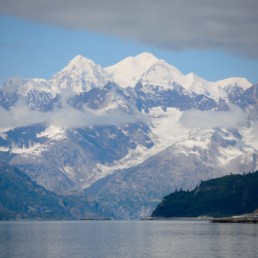
On the horizon, against a bright blue sky, stood the great, ancient mothers, snow-covered peaks keeping watch over time and generations, from sea to ice and back again, as well as the daily push and pull of tides.
In one holy moment I was perfectly still, in the midst of all that is living. In moments the tide would begin to reverse, and the gentle trickle of river to sea would be overcome with the rushing of saltwater in an impressive reversal of flow. We had been sitting in the shadow of a ten-foot granite boulder as we played in the pools, a boulder that we now watched submerging before our very eyes. The miraculous occurs every day, sometimes as regularly as the tides, but we simply lack a reference point to see it.
“Life shrinks or expands in proportion to one’s courage.”
-Anais Nin
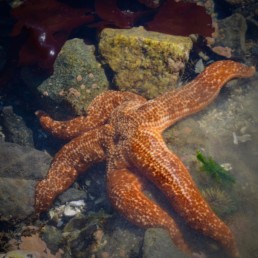
I am a traveler, and the wanderlust within compels me ever onward, walking, exploring, needing to see the world and always more of it. If I walk a little faster, a little further, I can momentarily soften regret for places I will never see, or never return to. Anais Nin once said, “Life shrinks or expands in proportion to one’s courage.” It takes courage to journey in this world, to escape our comfort zones and challenge our illusions. For some of us, the greater courage comes with sitting still, letting go, allowing the tide to drain and fill and reveal the wonders beneath. And so I sat, as still and clear as a tide pool, alive in the warmth of the sun, the delight of my children, the pull of the tides. The whales were breathing — and so was I.
